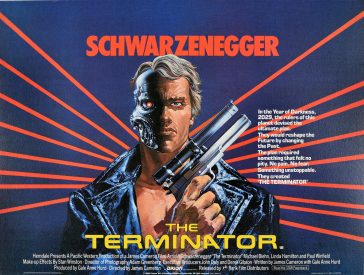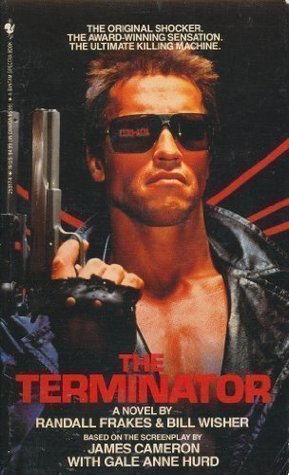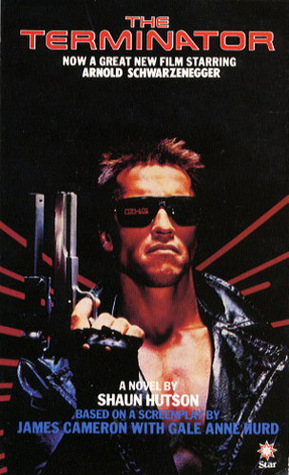 As I write this a new TERMINATOR movie, TERMINATOR: DARK FATE, has just been released, and is (unsurprisingly) bombing rather spectacularly. The seemingly never-ending TERMINATOR franchise is one of the most tired in Hollywood, but there was a time, believe it or not, when the material seemed fresh and exciting.
As I write this a new TERMINATOR movie, TERMINATOR: DARK FATE, has just been released, and is (unsurprisingly) bombing rather spectacularly. The seemingly never-ending TERMINATOR franchise is one of the most tired in Hollywood, but there was a time, believe it or not, when the material seemed fresh and exciting.
Having been there for THE TERMINATOR’S initial October 1984 release (yes, I’m old) I can attest that it was indeed the coolest movie on the scene back then. In looking back at this seminal classic, which has had no shortage of analysis over the decades, I’ll focus on the sole element relating to THE TERMINATOR that hasn’t already been picked over and/or argued about to death: the two novelizations it inspired, the first written by Shaun Hutson and published by the UK-based Star Books, and the second by Randall Frakes and Bill Wisher and published by the US-based Bantam.
In the days before the home video revolution really took hold novelizations and soundtrack albums were integral components of a movie’s release. Even in those rare cases when a movie’s soundtrack wasn’t released (such as TIME BANDITS) a novelization assuredly was–and written, oftentimes, by an established genre scribe. Early eighties examples of such include DEAD AND BURIED by Chelsea Quinn Yarbro, E.T.: THE EXTRA-TERRESTRIAL by William Kotzwinkle, TWILIGHT ZONE: THE MOVIE by Robert Bloch, the “Jack Martin” HALLOWEEN books of Dennis Etchison and the UK TERMINATOR by Shaun Hutson (who had already gotten a fair amount of attention for his pulp horror novels SLUGS, SPAWN and EREBUS.)
The idea of separate UK-US publications certainly wasn’t unprecedented when the dueling TERMINATOR novels were unveiled, having occurred back in 1978 with CAPRICORN ONE, which appeared in the UK in a novelization by “Bernard Ross” (a.k.a. Ken Follett) and then a US-issued one by Ron Goulart (there was also the case of FRIDAY THE 13th 3-D, the novelization of which appeared in 1983, in a UK-only edition by Michael Avallone that was supplanted by a Simon Hawke penned book in ‘85). What occurred here, though, is somewhat unique, with the Hutson book appearing in the UK in February 1985 and the Frakes-Wisher book in the US in October of that year; the latter was subsequently republished in 1991 in the UK, thus rendering Hutson’s book a forgotten outlier in both countries.
You know the story I’m sure: a humanoid cyborg (played by Arnold Schwarzenegger), referred to in the screenplay and novels as simply “Terminator,” is sent back in time from a future Earth in which machines have taken over. Terminator’s mission: to kill Sarah Conner (Linda Hamilton), an unassuming LA waitress who is set to birth John Connor, the leader of a human resistance against the machines. Not to be outdone, Conner and his fellows send back Kyle Reese (Michael Biehn), a soldier and, unbeknownst to Reese himself, John Conner’s father, to stop the Terminator. Lots of breakneck action and mayhem ensues, with Terminator getting increasingly banged up and Sarah gradually coming into her own as a warrior.
Terminator 1984
Terminator II: Judgement Day 1991
Terminator: Dark Fate 2019
Of the novelizers Frakes and Wisher had a decidedly unfair advantage. They, after all, were close friends of THE  TERMINATOR’s writer-director James Cameron (Frakes co-directed Cameron’s 1978 debut film XENOGENESIS, in which Wisher was the lead actor), and both reportedly had a fair amount of input on the screenplay.
TERMINATOR’s writer-director James Cameron (Frakes co-directed Cameron’s 1978 debut film XENOGENESIS, in which Wisher was the lead actor), and both reportedly had a fair amount of input on the screenplay.
There’s also the fact that their TERMINATOR appeared nearly a full year after the film’s release, suggesting that Frakes and Wisher had seen it before writing the book. Many small but important changes were made from the TERMINATOR shooting script to the final film, such as Sarah showing an early instance of fighting spirit by forcibly getting Reese to surrender to the cops after a second act car chase, which is detailed by Frakes and Wisher but not by Hutson, whose description of the scene is just as it was in the script: Reese gets out of the car and surrenders without any prompting from Sarah. An even more dramatic example of Frakes and Wisher’s privileged status occurs a bit later, when Terminator, confronting a police officer, utters the film’s most iconic line–a line that Frakes/Wisher put down as “I’ll be back,” just it was in the film, but which Hutson, following the script, renders in far less forceful fashion as “I’ll come back.”
Frakes and Wisher also layer in more character and incidental detail than what we saw onscreen. This is evident mostly in Reese’s detailed flashbacks to the nightmarish future world from which he originates, which is fleshed out far more memorably and satisfyingly than it was in TERMINATOR SALVATION, which was set entirely within that future world. The wealth of detail extends to the story’s LA settings, which the authors are careful to identify by location (i.e. the Century City ABC Entertainment Center) and Street/Freeway name.
Hutson’s book is far more perfunctory overall, but can’t be dismissed altogether, nicely capturing as it does the film’s B-movie veneer. THE TERMINATOR may have inspired a highly costly franchise—TERMINATOR II: JUDGEMENT DAY, with its reported $100 million budget, was at one time the most expensive movie ever made, and TERMINATOR: DARK FATE’s cost is said to have doubled that—but it, let’s not forget, was a low budget production whose star dismissed it early on as “some shit movie I’m doing, take a couple weeks.” The film, in fact, resembles nothing so much as 1980s Roger Corman science fiction programmers like BATTLE BEYOND THE STARS and GALAXY OF TERROR (which is appropriate, as James Cameron worked on both–as for that matter did Messrs. Frakes and Wisher). Like those films THE TERMINATOR, thoughtful and inspired though it is, emphasized action and sensation, with exposition doled out amid car chases and shoot-outs, much excess carnage and a scene in which Sarah and Reese, despite being in the midst of a pursuit involving both the Terminator and the LAPD, find time for a motel room tryst.
 Hutson’s TERMINATOR, at 172 pages, is first and foremost shorter than the other book (whose page count clocks in at 240). No extra character or plot detail is offered by Hutson, who follows the script quite closely. His book is rendered in brief chapters and unpretentious prose that better approximates the headlong rush of the film than Frakes and Wisher’s more expansive, description-heavy treatment.
Hutson’s TERMINATOR, at 172 pages, is first and foremost shorter than the other book (whose page count clocks in at 240). No extra character or plot detail is offered by Hutson, who follows the script quite closely. His book is rendered in brief chapters and unpretentious prose that better approximates the headlong rush of the film than Frakes and Wisher’s more expansive, description-heavy treatment.
One area, however, in which Hutson outdoes Frakes and Wisher in excess is in his descriptions of gore (which will comes as no surprise to anyone familiar with Hutson’s other novels). In the Hutson TERMINATOR, for instance, the first act shooting of a gun store owner is as graphic as can be imagined–“He crashed forward again, a gaping hole through his upper torso. Gobbets of lung tissue and fragments of shattered bone stuck to the rear wall, plastered on by thick streaks of blood”—which stands in direct contrast to what Frakes and Wisher offer: “and then, a second before the shotgun blast, in a quiet revelation, he realized that he should have stayed in Maine.”
Thus we have two TERMINATOR novels, each with its own virtues and drawbacks. The clear and obvious verdict is that the Frakes-Wisher book is the better of the two, but the Hutson TERMINATOR shouldn’t be discounted.
Of the subsequent TERMINATOR novelizations, TERMINATOR 2: JUDGEMENT DAY, published in the US and the UK in June 1991, was again drafted by Randall Frakes (from a screenplay co-written by William Wisher), and very much in keeping with Frakes and Wisher’s previous novelization. This is to say that it’s quite expansive, going far above and beyond standard movie novelization etiquette in its characterizations and descriptions.
The rest of the TERMINATOR novels, like the movies they adapted, can be dismissed. TERMINATOR 3: RISE OF THE MACHINES by David Hagberg and TERMINATOR SALVATION by Alan Dean Foster (no official novelizations of TERMINATOR GENISYS or TERMINATOR: DARK FATE have been attempted) have a lot of problems, starting with the fact that neither was written by Randall Frakes, William Wisher or Shaun Hutson, who in textual format can be said to truly own this material now and forever.
